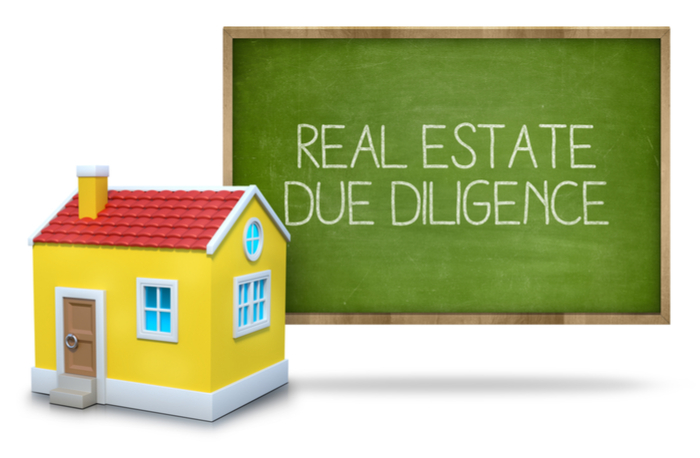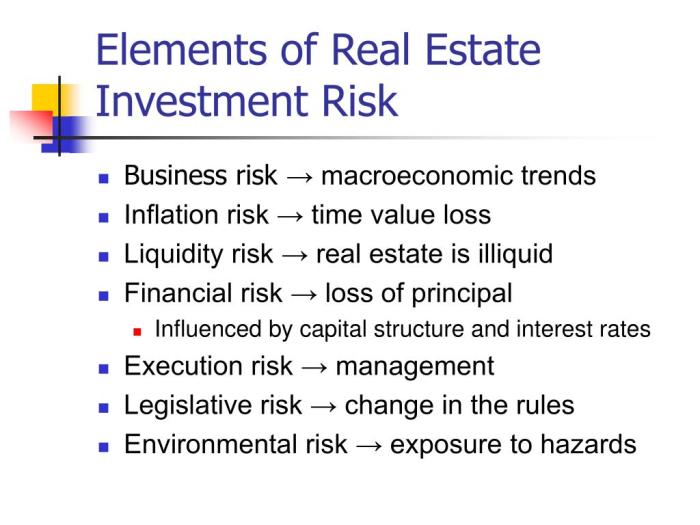What is due diligence real estate? It’s the crucial investigative process buyers undertake before committing to a property purchase. This comprehensive examination safeguards against unforeseen problems and ensures a sound investment. From scrutinizing legal documents to assessing environmental risks, due diligence provides a clear picture of the property’s condition and potential liabilities, ultimately empowering informed decision-making and minimizing financial hazards.
The process typically involves several stages, starting with initial property research and progressing through detailed financial, legal, and environmental reviews. Each stage is designed to uncover potential issues, allowing buyers to negotiate favorable terms or withdraw from the transaction if necessary. A thorough due diligence process is not merely a formality; it’s a vital investment protecting buyers from costly mistakes and ensuring a successful real estate transaction.
Types of Due Diligence

Real estate due diligence is a critical process involving a thorough investigation of a property before a purchase or investment. It aims to mitigate risks and ensure the transaction aligns with the buyer’s expectations. Several types of due diligence are typically conducted, each focusing on a specific aspect of the property and its surrounding environment. A comprehensive due diligence process involves a combination of these types to provide a holistic view.
Different types of due diligence are conducted depending on the nature of the property, the buyer’s goals, and the specific risks involved. The most common categories include financial, legal, and environmental due diligence. Understanding the nuances of each type is crucial for making informed decisions and protecting investment interests.
Financial Due Diligence
Financial due diligence examines the financial health and performance of the property. This involves analyzing financial statements, rent rolls (for income-producing properties), operating budgets, and other relevant financial data to assess the property’s profitability and potential for future returns. The goal is to verify the accuracy of financial information provided by the seller and identify any potential financial risks or inconsistencies.
This might include scrutinizing historical income and expense data to identify trends and potential issues, reviewing lease agreements to understand occupancy rates and rental income streams, and assessing the property’s debt structure and loan terms. For example, a discrepancy between reported income and actual bank deposits might indicate potential misrepresentation, while a high vacancy rate could signal underlying market challenges.
Legal Due Diligence
Legal due diligence focuses on the legal aspects of the property and the transaction. This includes reviewing title reports, surveys, permits, leases, and other legal documents to ensure clear ownership, identify any encumbrances (such as liens or easements), and verify compliance with all relevant laws and regulations. This is crucial for ensuring a smooth transfer of ownership and avoiding potential legal disputes.
For instance, a poorly executed survey could reveal boundary disputes with neighboring properties, while an overlooked easement could significantly impact the property’s usability. A thorough review of zoning regulations is essential to ensure the property’s permitted use aligns with the buyer’s intended purpose.
Environmental Due Diligence
Environmental due diligence assesses the environmental condition of the property and surrounding areas. This involves identifying and evaluating potential environmental hazards, such as contamination from previous uses, presence of hazardous materials (like asbestos or lead paint), and compliance with environmental regulations. Environmental concerns can significantly impact the value and usability of a property, leading to costly remediation efforts.
For example, discovering soil contamination requires costly cleanup before the property can be safely used. Similarly, the presence of asbestos or lead paint might necessitate expensive abatement procedures. This due diligence often involves site inspections, environmental reports, and consultations with environmental professionals.
Commercial vs. Residential Property Due Diligence
While the fundamental principles of due diligence remain consistent across property types, the specific focus and depth of investigation differ between commercial and residential properties. Commercial due diligence tends to be more extensive and complex, given the higher value and often more intricate legal and financial structures involved. Residential due diligence, while still important, typically focuses on more straightforward aspects like title issues, property condition, and compliance with building codes.
For instance, a commercial property due diligence investigation would include a detailed review of the lease agreements, tenant occupancy, and market analysis, which would be less critical in a residential transaction.
| Type | Focus | Methods | Key Deliverables |
|---|---|---|---|
| Financial Due Diligence | Property’s financial health and performance | Review of financial statements, rent rolls, operating budgets, analysis of income and expenses | Assessment of profitability, identification of financial risks, valuation |
| Legal Due Diligence | Legal aspects of the property and transaction | Review of title reports, surveys, permits, leases, legal documents | Verification of clear ownership, identification of encumbrances, confirmation of legal compliance |
| Environmental Due Diligence | Environmental condition of the property | Site inspections, environmental reports, consultations with environmental professionals | Identification of environmental hazards, assessment of environmental risks, compliance verification |
Financial Due Diligence Procedures

Financial due diligence in real estate is crucial for assessing the financial viability of a property and its owner. A thorough examination of financial records helps investors understand the property’s profitability, potential risks, and overall investment value. This process involves verifying the accuracy and reliability of financial data presented by the seller, uncovering any potential hidden liabilities, and ultimately making an informed investment decision.
Methods for Verifying Financial Health
Verifying the financial health of a property and its owner involves a multi-faceted approach. This includes independently verifying income and expense figures through reviewing historical financial statements, analyzing operating budgets, and comparing this data to market benchmarks for similar properties in the same area. Furthermore, it involves investigating the owner’s financial standing through credit reports and reviewing their personal financial statements to assess their ability to meet their financial obligations.
Any discrepancies between the provided information and the findings of the independent verification should be thoroughly investigated and explained.
Analysis of Financial Statements
Analyzing income statements, balance sheets, and cash flow statements provides a comprehensive view of the property’s financial performance. The income statement reveals the property’s revenue and expenses over a specific period, highlighting its profitability (or lack thereof). The balance sheet presents a snapshot of the property’s assets, liabilities, and equity at a particular point in time, providing insights into its financial position.
The cash flow statement tracks the movement of cash into and out of the property, demonstrating its liquidity and ability to meet its financial obligations. A comparative analysis of these statements across multiple years reveals trends and patterns in the property’s financial health. For example, a consistent decline in net operating income (NOI) could indicate underlying problems requiring further investigation.
Financial Ratios in Real Estate Evaluation
Several key financial ratios are used to evaluate real estate investments. These ratios provide standardized metrics for comparing different properties and assessing their relative risk and return.
- Capitalization Rate (Cap Rate): Calculated as NOI divided by the property’s value (Cap Rate = NOI / Property Value). A higher cap rate generally indicates a higher return on investment, but it’s crucial to consider the associated risks.
- Debt Service Coverage Ratio (DSCR): Calculated as NOI divided by annual debt service (DSCR = NOI / Annual Debt Service). A DSCR greater than 1 indicates that the property generates enough income to cover its debt obligations.
- Loan-to-Value Ratio (LTV): Calculated as the loan amount divided by the property’s value (LTV = Loan Amount / Property Value). A lower LTV suggests a lower risk for lenders and investors.
These ratios should be compared to industry benchmarks and similar properties to determine if the investment is attractive and aligns with the investor’s risk tolerance. For example, a property with a significantly lower cap rate than comparable properties might signal an overvalued asset or indicate potential issues.
Critical Financial Documents for Review
A comprehensive due diligence process requires reviewing a range of financial documents. This list is not exhaustive but highlights some of the most important documents:
- Income and Expense Statements (at least three years)
- Balance Sheets (at least three years)
- Cash Flow Statements (at least three years)
- Rent Rolls (current and historical)
- Lease Agreements
- Operating Budgets
- Tax Returns (property and owner)
- Loan Documents (including amortization schedules)
- Insurance Policies
- Appraisals
Thorough review of these documents, alongside independent verification of the data they contain, is vital to making a sound investment decision. Inconsistencies or missing information should be addressed before proceeding.
Environmental Due Diligence Procedures

Environmental due diligence in real estate involves assessing potential environmental liabilities associated with a property. This process is crucial for protecting buyers and investors from unforeseen costs and legal issues stemming from past or present environmental contamination. A thorough assessment helps mitigate risks and ensures informed decision-making throughout the acquisition process.
Environmental Site Assessments, What is due diligence real estate
Conducting an environmental site assessment typically involves a phased approach, starting with a preliminary review of available records and progressing to more intrusive investigations if necessary. Phase I assessments generally involve a review of historical records, site reconnaissance, and interviews with stakeholders to identify potential environmental concerns. Phase II assessments may include soil and groundwater sampling to confirm the presence and extent of contamination.
Phase III assessments focus on detailed site characterization and remediation planning if contamination is found. The specific phases required depend on the property’s history and the level of risk involved. For example, a property previously used as a gas station would require a more extensive assessment than a residential property with no known history of contamination.
Potential Environmental Hazards in Real Estate
Several environmental hazards can significantly impact the value and usability of a property. These include soil and groundwater contamination from past industrial activities, leaking underground storage tanks (LUSTs), asbestos, lead-based paint, radon gas, mold, and the presence of hazardous waste. The presence of these hazards can lead to significant remediation costs, regulatory penalties, and potential health risks. For instance, asbestos abatement can be extremely costly, requiring specialized contractors and disposal procedures.
Similarly, the cleanup of a leaking underground storage tank can involve extensive excavation and groundwater remediation.
Understanding Environmental Regulations and Compliance
Navigating environmental regulations is a critical aspect of environmental due diligence. Various federal, state, and local laws govern the handling and remediation of environmental contamination. Understanding these regulations, including the Comprehensive Environmental Response, Compensation, and Liability Act (CERCLA) or Superfund, and the Resource Conservation and Recovery Act (RCRA), is crucial for determining liability and compliance requirements. Failure to comply with these regulations can result in significant fines and legal repercussions.
For example, a buyer who fails to address known contamination on a property could be held liable for cleanup costs even if they were not responsible for the initial contamination.
Interpreting Environmental Reports and Identifying Potential Remediation Costs
Environmental reports, such as Phase I, II, and III assessments, provide crucial information about a property’s environmental condition. Interpreting these reports requires a thorough understanding of environmental science and regulatory requirements. The reports should clearly identify any potential environmental hazards, their extent, and potential remediation strategies. Based on this information, potential remediation costs can be estimated. These estimates should consider various factors, including the type and extent of contamination, the chosen remediation technology, and regulatory requirements.
For instance, a report might indicate the presence of petroleum hydrocarbons in the soil, requiring excavation and disposal at a specialized facility, with associated costs dependent on the volume of contaminated soil and the regulatory requirements for disposal. Accurate cost estimations are crucial for informed decision-making during the acquisition process.
Illustrative Examples of Due Diligence Reports

Due diligence reports, while varying in specifics depending on the property and transaction, generally follow a similar structure. They present findings from various investigations and analyses, culminating in a summary of potential risks and opportunities. The following examples illustrate the stark differences between a report indicating a smooth path to closing and one revealing significant concerns.
Successful Transaction Due Diligence Report
This hypothetical report concerns the acquisition of a well-maintained, single-family residential property in a desirable suburban neighborhood. The property’s title search revealed clear ownership with no encumbrances. The environmental assessment found no contamination or hazardous materials. The financial review confirmed the seller’s representation of the property’s income and expenses, aligning with market value assessments. The structural inspection identified minor, easily rectifiable issues such as some cosmetic damage and a minor plumbing problem.
The overall assessment indicated minimal risk, and the transaction proceeded smoothly to closing. The report highlighted the strong financial position of the seller, the desirable location of the property, and the low level of risk associated with the purchase. The recommendations section simply advised the buyer to proceed with the transaction, subject to the minor repairs Artikeld in the structural inspection.
Transaction with Significant Issues Due Diligence Report
This report details the due diligence conducted on a commercial property, a multi-tenant office building in an older urban area. The title search uncovered a complex ownership structure with multiple liens and outstanding tax obligations. The environmental assessment revealed significant soil contamination requiring expensive remediation. The financial review uncovered discrepancies between the seller’s reported income and actual financial records, indicating potential misrepresentation.
The structural inspection discovered significant foundation issues requiring extensive and costly repairs. Further investigation into the building’s occupancy revealed several lease agreements nearing expiration with no evidence of renewal negotiations. The report ultimately highlighted several substantial risks, including significant financial liabilities, environmental remediation costs, and potential vacancy issues. The recommendations section strongly advised against the acquisition unless the seller agreed to substantial price reductions to account for the discovered issues, or the buyer was prepared to undertake significant financial investments in remediation and repairs.
The report detailed the potential cost implications of each issue, providing a comprehensive financial analysis of the risks involved.
Last Word: What Is Due Diligence Real Estate

In conclusion, understanding what is due diligence real estate is paramount for anyone navigating the complexities of property acquisition. By diligently conducting thorough investigations across financial, legal, and environmental aspects, buyers can significantly reduce risks, make informed decisions, and protect their investment. The process, though demanding, ultimately fosters confidence and contributes to the overall success of the real estate transaction.
Remember, a proactive approach to due diligence is an investment in a secure and profitable future.